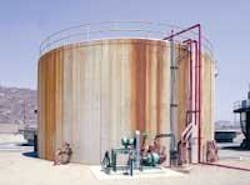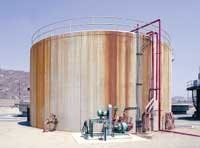Mixing System Improves Digester Performance, Gas Production
By Paul Cockrell
The Moreno Valley Regional Wastewater Reclamation Facility (RWRF) is one of several wastewater facilities operated by California's Eastern Municipal Water District (EMWD) that incorporate anaerobic digesters. In April through June 2001, the gas mixing systems of the facility's four anaerobic digesters were replaced with new mixing systems designed to improve digester performance and gas production.
The Moreno Valley RWRF is an activated sludge facility, and the major wastewater processes are degritting, primary clarification, activated sludge, secondary clarification, filtration and chlorination. The solids processing facilities include sludge thickening (DAFs) and anaerobic digestion, followed by belt press dewatering. The facility currently treats an average flow of 8-9 mgd.
There are four 48 ft. diameter, 22 ft. sidewater depth digesters, with a total active volume of about 1.2 million gallons. The digesters have been in operation for over 20 years. Sludge heating is with hot-water bath type sludge heaters. The digester gas is used in engine-driven blowers, and hot water is recovered from the jacket water waste heat for digester heating.
The original digester gas mixing systems were replaced with small internal pump mixers about 10 years ago, in an effort to improve digester performance. Plant staff report that the internal pump mixers were too small, and consequently were only effective for the top layer of the digesters. In 1998, EMWD experimented with larger external pump mixing systems at its Hemet/Jacinto facility, and saw a significant increase in digester gas production. It was decided to install similar external pump mixing systems for each of the four Moreno Valley digesters, and also use internal mixing nozzles. The digester mixing system selected was the Rotamix system from Vaughan Company, Inc.
Each digester mixing system consists of a 2,100 gpm Vaughan Chopper Pump and four internal nozzles sized and oriented to provide a dual-zone rotational mixing pattern. These pumps provide the flow necessary to give 90% complete mixing in 30 minutes, which is Vaughan's primary design criterion.
Using the available average biosolids flow and volatile solids (VS) data, the four digesters have a solids retention time of about 14 days, and a VS loading rate of 0.15 Lb VS/cf/day. Both values are within normal design criteria for anaerobic digesters.
Digester performance usually can be determined from volatile solids destruction and/or digester gas production. At this facility digester gas production is a more reliable measure of digester performance, as the available solids data vary significantly from month to month.
Digester Gas System
For digester gas metering, the facility uses thermal dispersion mass flow meters. As a check on the digester gas meters, the flow at the waste gas meter was compared to the sum of the digester gas meter flows during a period when no digester gas utilization equipment was operating. The waste gas flare meter read slightly higher than the digester gas meters; however, the two readings tracked each other. During normal plant operation digester gas is rarely flared.
At Moreno Valley a high-pressure digester gas storage sphere is used to allow the engine-blowers to operate a portion of the day fully loaded on digester gas. When the storage sphere is depleted, the engine-blower is switched to natural gas and the sphere is slowly recharged. Before the digester mixing project was installed, digester gas production was sufficient to only operate the engine-blowers for about 12 hours per day.
With the new pump mixing and nozzle system, the measured digester gas production increased about 80% on average. At an average cost of $0.50/therm for natural gas, the increase in digester gas production saves about $60,000 per year in natural gas purchases.
An increase in gas production means greater VS destruction, which also means less biosolids to dewater. This reduces the operational cost of the dewatering facility and the hauling and disposal costs.
Mixing Energy Consumption
Well-mixed digesters react quickly to biosolids feeding. Digester gas production typically increases rapidly and the surge is gone in about 30 minutes. Vigorous, well-mixed digesters also tend to produce more digester gas.
In an effort to minimize electrical energy consumption, each of the newly installed Rotamix systems at Moreno Valley are only operated when the digesters are being fed and for a short period afterwards. Raw sludge feed rotates around to each digester, based on time. On average, about 1.5 of the for mixing systems are continuously operating. The measured gas production data indicates the digesters are performing well with this mixing schedule.
The mixing pumps are 30 HP each, and the original gas mixing compressors were 50 HP each, and they were operated continuously. The net reduction in energy consumption due to pump mixing is about 100 KW, which at $0.15/KWH is a savings of about $130,000 per year.
Plant staff report that the only problem they have had with the pump mixing system was gas binding which was resolved quickly. Because each pump is turned off periodically, gas generated in the suction piping would build up in the suction elbow. Plant staff solved this problem by installing a two inch line from the top of each suction elbow back to the digester. They have not had problems with clogging of the pumps or flow nozzles.
Project Economics
Besides improving digester performance, the project resulted in some significant, easily quantified, operating cost savings due to reduced electrical and natural gas energy consumption. Together these savings amount to about $200,000 per year. With a total installed capital cost of $400,000, the simple payback period is two years. Cost savings due to reduced solids dewatering, hauling and disposal are not readily quantified, and therefore not included in the project economics.
There are various state run energy conservation rebate programs applicable to this type of project, which can significantly improve the project economics. One third of the project was funded by a state grant, based on energy savings.
The project summary and conclusions are:
The overall average increase in measured digester gas production, seen after installation of the external pump mixing system and flow nozzles, is about 80%. This improvement in digester performance is due to the digester mixing modifications.
Operation of the pump mixing systems only during and just after digester feeding appears to be sufficient and reduces electrical energy consumption significantly.
The increase in digester gas production and reduction in mixing energy creates sufficient cost savings to give the project a 2-year simple payback period.
About the authors: Steve Ingersoll is the plant manager at the Eastern Municipal Water District Moreno Valley Water Reclamation Plant. He can be contacted at [email protected]. Paul Cockrell is a mechanical wastewater design engineer specializing in anaerobic digesters, digester gas utilization, and energy conservation. He can be contacted at [email protected].

